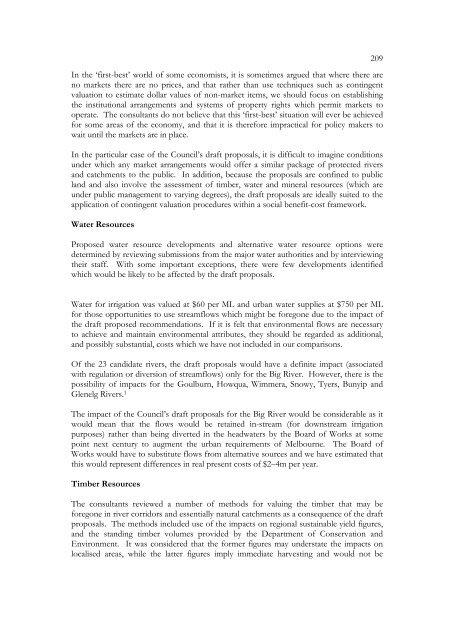APPENDIX I List Of Submissions - Victorian Environmental ...
APPENDIX I List Of Submissions - Victorian Environmental ...
APPENDIX I List Of Submissions - Victorian Environmental ...
Create successful ePaper yourself
Turn your PDF publications into a flip-book with our unique Google optimized e-Paper software.
In the ‘first-best’ world of some economists, it is sometimes argued that where there are<br />
no markets there are no prices, and that rather than use techniques such as contingent<br />
valuation to estimate dollar values of non-market items, we should focus on establishing<br />
the institutional arrangements and systems of property rights which permit markets to<br />
operate. The consultants do not believe that this ‘first-best’ situation will ever be achieved<br />
for some areas of the economy, and that it is therefore impractical for policy makers to<br />
wait until the markets are in place.<br />
In the particular case of the Council’s draft proposals, it is difficult to imagine conditions<br />
under which any market arrangements would offer a similar package of protected rivers<br />
and catchments to the public. In addition, because the proposals are confined to public<br />
land and also involve the assessment of timber, water and mineral resources (which are<br />
under public management to varying degrees), the draft proposals are ideally suited to the<br />
application of contingent valuation procedures within a social benefit-cost framework.<br />
Water Resources<br />
Proposed water resource developments and alternative water resource options were<br />
determined by reviewing submissions from the major water authorities and by interviewing<br />
their staff. With some important exceptions, there were few developments identified<br />
which would be likely to be affected by the draft proposals.<br />
209<br />
Water for irrigation was valued at $60 per ML and urban water supplies at $750 per ML<br />
for those opportunities to use streamflows which might be foregone due to the impact of<br />
the draft proposed recommendations. If it is felt that environmental flows are necessary<br />
to achieve and maintain environmental attributes, they should be regarded as additional,<br />
and possibly substantial, costs which we have not included in our comparisons.<br />
<strong>Of</strong> the 23 candidate rivers, the draft proposals would have a definite impact (associated<br />
with regulation or diversion of streamflows) only for the Big River. However, there is the<br />
possibility of impacts for the Goulburn, Howqua, Wimmera, Snowy, Tyers, Bunyip and<br />
Glenelg Rivers. 1<br />
The impact of the Council’s draft proposals for the Big River would be considerable as it<br />
would mean that the flows would be retained in-stream (for downstream irrigation<br />
purposes) rather than being diverted in the headwaters by the Board of Works at some<br />
point next century to augment the urban requirements of Melbourne. The Board of<br />
Works would have to substitute flows from alternative sources and we have estimated that<br />
this would represent differences in real present costs of $2–4m per year.<br />
Timber Resources<br />
The consultants reviewed a number of methods for valuing the timber that may be<br />
foregone in river corridors and essentially natural catchments as a consequence of the draft<br />
proposals. The methods included use of the impacts on regional sustainable yield figures,<br />
and the standing timber volumes provided by the Department of Conservation and<br />
Environment. It was considered that the former figures may understate the impacts on<br />
localised areas, while the latter figures imply immediate harvesting and would not be
















